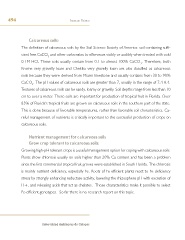Page 494 - FRUTAS DEL TRÓPICO
P. 494
494 Frutas del trópico
Calcareous soils:
The definition of calcareous soils by the Soil Science Society of America: soil containing suffi-
cient free CaCO and other carbonates to effervesce visibly or audibly when treated with cold
3
0.1M HCl. These soils usually contain from 0.1 to almost 100% CaCO . Therefore, both
3
Krome very gravelly loam and Chekika very gravelly loam are also classified as calcareous
soils because they were derived from Miami limestone and usually contains from 30 to 90%
CaCO . The pH values of calcareous soils are greater than 7, usually in the range of 7.4-8.4.
3
Textures of calcareous soils can be sandy, loamy or gravelly. Soil depths range from less than 10
cm to over a meter. These soils are important for production of tropical fruit in Florida. Over
85% of Florida’s tropical fruits are grown on calcareous soils in the southern part of the state.
This is done because of favorable temperatures, rather than favorable soil characteristics. Ca-
reful management of nutrients is critically important to the successful production of crops on
calcareous soils.
Nutrient management for calcareous soils
Grow crop tolerant to calcareous soils:
Growing high-pH tolerant crops is a useful management option for coping with calcareous soils.
Plants show chlorosis usually on soils higher than 20% Ca content and has been a problem
since the first commercial tropical fruit groves were established in South Florida. The chlorosis
is mainly nutrient deficiency, especially Fe. Roots of Fe-efficient plants react to Fe-deficiency
stress by strongly enhancing reductase activity, lowering the rhizosphere pH with excretion of
H+, and releasing acids that act as chelates. Those characteristics make it possible to select
Fe-efficient genotypes. So far there is no research report on this topic.
Universidad Autónoma de Chiapas

